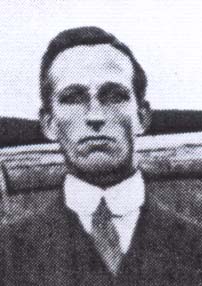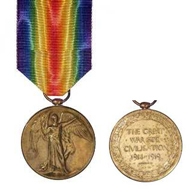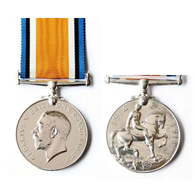CAPLICK Richard (Dick) August
-

- 390 and 6914
- Private
- Acting Lance Corporal
- 26 Battalion
- 11 Depot Battalion, 5th Reinforcements of 4th Pioneers, 5th Reinforcements of 7th Machine Gun Company, No 6 Company Seymour Machine Gun Depot, 7th Reinforcements of 9th Machine Gun Company
- Eumundi
- Yes
- 17 August 1893
- Canungra, Queensland
- 29 March 1916 & 8 May 1917
- HMAT Hororata A20
- 14 June 1917
- Sydney
-
Richard (Dick) Caplick was the 6th of 11 children born to his parents Fredericka Johanna Gruhl and Frederick Wilhelm August Caplick on 17 August, 1893 at Canungra, Queensland. His parents were both born in Germany and immigrated the first chance they got from a country they regarded was ruled by a tyrant, namely the Kaiser.
His siblings were:
Auguste Johanna Caplick (1883-1970)
Marie Wilhelmine Caplick (1886-1978)
Wilhemine Bertha Caplick (1889-1971)
William Ferninand Caplick (1890-1909)
Ferdinand William Caplick (1891-1977)
August Richard Caplick (1895-1943)
Otto Wilhelm Caplick (1897-1934)
Martha Louise Caplick (1899-1994)
Reinhold Otto Caplick (1901-1997)
Edith Maud Caplick (1904-1905)First settling in Canungra they moved to Coomera, Maroochy River, Yandina and finally settled in Eumundi in 1901. He was schooled at the Provisional School in Eumundi. The teacher at Eumundi treated Dick as a favourite sending him on chores to Nambour and also doing all sorts of jobs for him. The teacher and his wife were childless and they wanted to adopt Dick but his father felt that Dick was an asset to the family at home.
Frederick Caplick had a selection of land out where the current Eumundi Cemetery is now located. It was covered in timber and the family cleared the timber which was the main industry of the town and sowed grass to raise cattle on it. Some of this timber was exported to South Africa as railway sleepers. His father never bought cattle but instead came home with horses and started a carrying company. They carted timber from the saw mill out to the various farms in the district where farmhouses were being built. Dick left school at the age of twelve and went into the bush to work building fencing. By the time he was seventeen he and his brother, August, were clearing the bush in Doonan and in the following year they cut a block of 73 acres for the Ball family, pioneer land owners in the area. Dick was regarded as a master of the springboard in the timber cutting industry. He was also an expert at what was called a “drive”. The timber getters mapped out a section of trees with a big tree up on the hill and cut the trees half way lower down on the uphill side and then fall the big tree. One tree would push another over and so on down the hill. Some drives were so large that the roar of the trees falling could be heard for miles.
Timber getting kept Dick in constant employment up to the time he was 22. Dick’s father had died in 1916 and he asked his mother if she approved of him going to fight the Germans for Australia. He was keen to enlist as all his school mates were joining up for the war. She said that Australia was their country now and if you want to go, you go. He enlisted in Brisbane on 29 March, 1916 and was placed in the 5th Reinforcements of the 7th Machine Gun Company. He was a man standing 6’0” (182 centre metres) and 150 lbs (68 kgs) in weight. He was blue eyed with light brown hair and followed the Church of England religion. His occupation as a timber getter had marked him with seven distinctive scars and he had tattoos. Prior to enlisting he had suffered a hernia from lifting a heavy log and also had a knee condition from a fall however he still passed his military medical. He became a member of the 7th Machine Gun Company (Service No 90) and initial training took place at Seymour, Victoria. At Seymour on 28 September, 1916 a Medical Board found that he was unfit due to previous injuries and he was discharged as military unfit on 5 October, 1916.
A determined man who wanted to serve his country, he was not deterred by his previous medical history and re-enlisted at Brisbane on 8 May, 1917 in the 20th reinforcements of the 26th Infantry Battalion. A month later he was on board the troopship “Hororata” sailing from Sydney to Liverpool. Upon arrival in August, 1917 the reinforcements were sent by train to training on Salisbury Plains. Here fresh recruits were taught the latest techniques of trench warfare. Two days after arriving in England, Dick was struck down by mumps and admitted to hospital. These were the days before immunisation and childhood diseases such as measles and mumps could spread like wildfire through a camp or a troopship. Many of the recruits like Dick were from isolated country regions and they were often the first to contract these illnesses.
After a few months the reinforcements were sufficiently trained to be sent to France. Dick Caplick joined his 26th Battalion in Belgium on 13 January, 1918. On 13 July, 1918 the 26th Battalion was deployed to the village of Villers-Bretonneux to help stem a German invasion which was threatening vital supply lines. The Battalion pushed the Germans back to a position where a German Tank, A7V, was stuck in a trench. Lt Col Robinson, Commanding Officer of the 26th Battalion, determined to have the disabled tank, Mephisto, returned to Queensland. For two nights, working parties were sent out to prepare the tank for retrieval. Under cover of a bombardment on the third night, the Mephisto was towed about three miles behind the Australian lines by a British tank. Soldiers, among them Dick Caplick, scratched their names on the side of the tank but these have been over painted in the course of the years. In June, 1919 the tank was finally towed to the Queensland Museum. To mark the centenary of World War 1, the Australian War Museum, Canberra is exhibiting the Mephisto in Anzac Hall. Twenty A7V tanks were manufactured during the war but Mephisto is the last surviving one and a rarity.
The 26th Battalion as part of the 2nd Australian Division took part in a battle at Wiancourt on 3 October, 1918. The attack was to start at 6.05 am and Dick was a part of it. He was wounded in the jaw, chest and elbow and has very little memory of it other than he was carried by four prisoners of war from the Field Ambulance Brigade to the Casualty Clearance Station. He woke up on an ambulance train on his way to Birmingham. Whilst he was convalescing from his wounds he took the opportunity to contact a girl who had written a letter to “A lonely Australian Soldier” which had been given to him in France. Her name was Mary Helen Armstrong and she lived in Canonbie near the English-Scottish border. He was treated like a hero and they had a wonderful time.
Dick Caplick was in London when the Armistice was declared on 11 November, 1918 and he remembers it as a gay little village that night. He recalled that Australian soldiers stopped a lorry loaded with beer near Trafalgar Square and put out kegs of beer all around Nelson’s Monument. Free for all – donated by the Aussies. He was invalided back to Australian, leaving London on 12 December, 1918. He was discharged from the army on 11 March, 1919.
After the war, Dick married Maud Sanderson whom he had known since before the war. He was granted a soldier’s settlement at Eerwah but for the most part this was unsuccessful. He moved to Sieb Road where he built a war service home and grew bananas. This was a very successful enterprise and he was able to pay off his home quickly. They had two children, Helen and Alan. His wife passed away in 1979 and then his daughter leaving Dick on his own. In his old age he moved to Nambour Nursing Home until his death on 4 November, 1987.
Richard (Dick) Caplick is remembered in Eumundi as one of its pioneers and characters. Where Etheridge’s Sawmill once stood there is a beautiful park next to the Eumundi Markets which is called Caplick Park. Local inhabitants picnic there and children play in the playground. He is also memorialised by a road called Caplick Way.
- Western Front
- Villiers Bretonneux, Wiancourt
-

-

- Returned to Australia
- Discharged 11 March 1919
- 4 November 1987
- Nambour
- 94
- Nambour Cemetery
-
Eumundi & District Roll of Honour Board, Eumundi Memorial School of Arts Hall, Memorial Drive, Eumundi
Eumundi Methodist Church and Sunday School Honour Board, Eumundi Museum, Memorial Drive, Eumundi
Maroochy Shire Honor Roll, Shire Chambers, Bury Street, Nambour
Nambour (Maroochy Shire) Roll of Honor Scroll, Private Collection, Nambour (this scroll was available for sale to the public after the war) -
Sources: Service records – National Archives of Australia
Personal History – Interview with Caroline Foxton on 14 February, 1985
War Diaries, October, 1918 - https://www.awm.gov.au/collection/RCDIG1005307/
Dick Caplick and German Tank – Discover Eumundi
Digger's Photo: "By Many Campfires", Caboolture Historical Society 1977, p143.
Tree felling image: Trove (National Library of Australia) - Yvonne Atkinson





